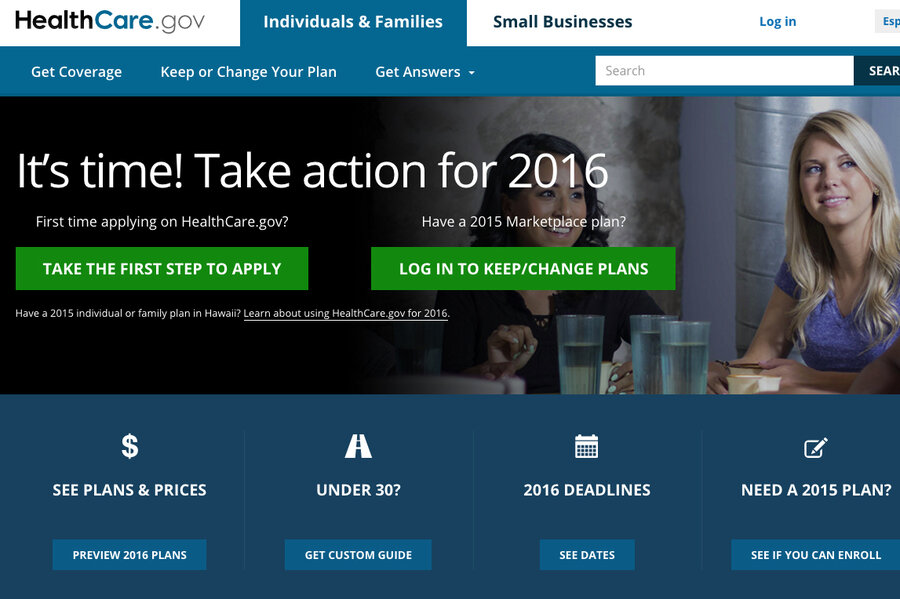As Obamacare enters Year 3, some signs of concern
Loading...
| Washington
The third year of Affordable Care Act enrollment got under way this week with little fanfare, but with a vital question still unsettled: Are the law’s insurance marketplaces a financially sustainable piece of America’s health-care system?
The question hangs in the air because several indicators suggest a possible financial squeeze for the marketplaces that offer subsidized insurance plans to Americans who don’t have government or employer-based coverage.
Premiums are rising faster for 2016 than they did for 2015. The pace of new enrollment appears to be slowing, judging by the Obama administration’s own forecasts. And county by county, Americans have fewer insurance companies to choose from than they did last November.
Taken together, none of this represents a clear signal that the marketplaces are falling apart. But the trends hint at how Obamacare runs the risk of financial instability if too few people enroll or if insurance companies decline to participate or face cost pressures that push premiums sharply higher.
Some health-insurance experts see cause for worry in the current trends of enrollment, prices, and insurer participation.
Enrollment
The general premise behind President Obama’s health-care law is that, with millions of Americans lacking insurance, state-based marketplaces should be set up so people can shop around (in some cases, aided by subsidies) among insurers who can’t deny coverage based on a person’s state of health.
Some 10 million people currently have Affordable Care Act coverage. Yet the Obama administration is forecasting a flat trend rather than growth in ACA enrollment for 2016, even though about 11.6 percent of adult Americans are uninsured, plus a smaller share of children.
“In order for a health insurance program to be sustainable and affordable, it must sign up many more healthy people than sick people in order to pay the costs of those who are sick,” Robert Laszewski, a consultant to the industry, writes in a recent column for the Forbes magazine website. “Since Obamacare is still relatively new we don’t know for certain what percentage of the total eligible we need to make the program work.”
But by his estimate, the overall ACA marketplace “is nowhere near where it needs to be in order to be sustainable.”
Some other experts say it’s far from clear that the marketplaces will become unsustainable. Perhaps enrollment numbers in the next few months will exceed the administration’s low expectations, for one thing.
And supporters of the law point to its successes, such as 9.4 million fewer adults saying they have trouble affording medical bills now, compared with 2013.
Prices
The level of upward pressure on premiums also remains to be seen.
By some measures, this year’s rate increases by insurers weren’t very steep – especially if you factor in the way subsidies soften the costs for families earning up to four times the poverty level.
The Kaiser Family Foundation, for example, looked at the ACA’s standard silver-quality plans in major cities in 49 states. Weighting the results by enrollment numbers in these cities, the foundation concluded that premiums are going up by an average of 3.6 percent for 2016. And the average premium change in these cities is actually a decline of 0.7 percent once subsidies are factored in, the analysis concluded.
The Obama administration, for its part, estimates that benchmark silver plans are rising by an average of 7.5 percent in 2016 across all 37 states with federally managed markets.
For individual households, though, what matters is prices where you live, not an overall average.
Avalere, a health industry consulting firm, looked at price trends for the lowest-cost silver plans in different parts of each state and found wide variations.
In Arizona, the average among low-cost silver plans is a 32 percent jump in premiums, compared with 2015. Oklahoma is experiencing a nation-leading 44 percent spike. Some states show declines, led by a 14 percent average decline in Indiana.
Nationwide, the average premium is rising 13 percent, by the Avalere measures, which are not weighted according to how many people enroll in a given place.
“While premiums have increased dramatically in many markets, the vast majority of exchange enrollees receive premium subsidies that can protect them from these increased costs,” Caroline Pearson, a senior vice president at Avalere, said in releasing the data on Oct. 30. “However, most consumers will need to return to the exchange to shop and may need to select a new plan to avoid higher premiums.”
Some analysts say premium hikes could accelerate a year from now, as a couple of reinsurance programs designed to assist participating insurance firms expire heading into 2017.
Insurer participation
With or without reinsurance aid, a big part of keeping prices under control is the scale of local marketplaces – having enough relatively healthy customers paying premiums and enough insurers competing to offer plans to those customers.
So far, insurer participation is solid in many markets, but with some worrisome signs of erosion.
Most people will have at least three insurers to choose from, and the Obama administration says the number of issuers has edged up to an average of 10 issuers per state, for the 37 states with a federal managed marketplace. But the Kaiser Family Foundation found that 40 percent of counties will have just one or two insurers, up from 35 percent of counties in 2015. And the number of counties with 5 or more insurers decreased in 2016.
On the enrollment front, one challenge is that the eligible people easiest to reach have already signed up. States with higher enrollment tend to have more robust efforts to promote enrollment and help people navigate their choices.
Another challenge, though, is affordability. Many people don’t feel they can afford plans, even with the subsidies, while others find the law’s tax penalty (for not having insurance) preferable to the cost of getting covered.








